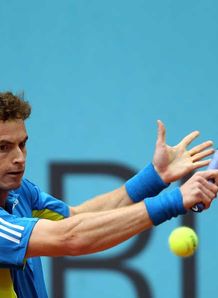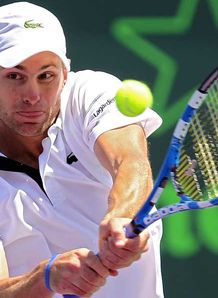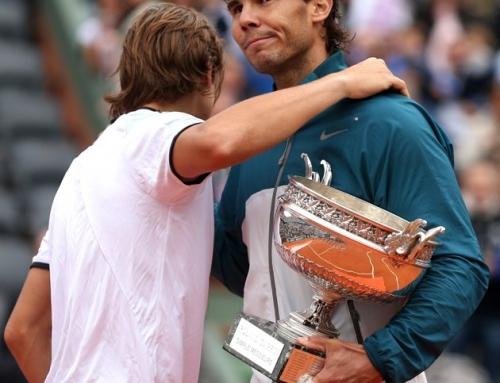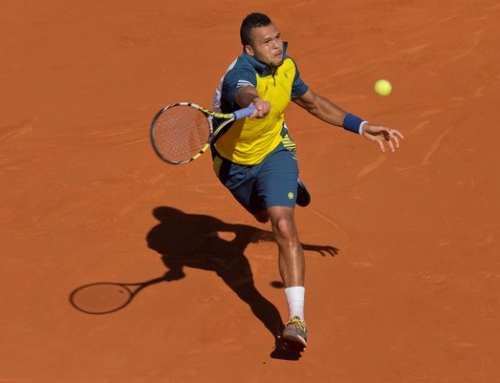I’ll do one preview now and maybe a modified preview once the draw is out. This preview is primarily based on how players are playing now.
Let’s start with the top contenders for the French Open.
Favorites
Rafael Nadal
 You have to give Rafa the nod heading into the French. Although there were some issues with his game heading into Monte Carlo (a semifinal loss in Miami and Indian Wells), all went well for him once he hit the clay. He had a dominating performance in Monte Carlo dropping the fewest games ever in all the times he’s won including a 6-0, 6-1 win over Fernando Verdasco to win his first title since Rome in 2009.
You have to give Rafa the nod heading into the French. Although there were some issues with his game heading into Monte Carlo (a semifinal loss in Miami and Indian Wells), all went well for him once he hit the clay. He had a dominating performance in Monte Carlo dropping the fewest games ever in all the times he’s won including a 6-0, 6-1 win over Fernando Verdasco to win his first title since Rome in 2009.
Rafa adjusted his schedule this year. Historically, he’s played four clay court tournaments, playing in Barcelona. However, this year he chose to skip Barcelona even though it is played on clay.
Rafa didn’t play nearly as well at Rome, dropping more games, and dropping his first set to Ernests Gulbis in the semifinal. Even so, he wasn’t pushed by anyone other than Gulbis.
Rafa saved his “best” tennis for Roger Federer. Although both played spotty tennis, Rafa played the big points well, which is one thing that was hurting him in his other losses. Consider Rafa’s loss to Davydenko in Doha. Up 6-0, he lost the second set in a tiebreak, and 6-4 in the third set. In these matches, you felt Rafa unable to grab hold of the match and close it out.
Another change to Rafa’s game is his increased level of aggression. Rather than play too passively, which he sometimes does when he gets nervous, he’s been trying to end points a little sooner. Not tremendously so, but somewhat so.
Roger Federer
 If you had to look at form from a little over a week ago, Roger Federer did not look like he would contend for the French. He lost in his opening round at Rome against Ernests Gulbis, despite Gulbis choking the first time he served for the match. He then said that he had work to do and he hoped to improve his play in Estoril. He looked about the same in Estoril, making errors, and unable to control the match and lost in the semifinals to the defending champ, Albert Montanes, who was nonetheless, out of the top 30 players.
If you had to look at form from a little over a week ago, Roger Federer did not look like he would contend for the French. He lost in his opening round at Rome against Ernests Gulbis, despite Gulbis choking the first time he served for the match. He then said that he had work to do and he hoped to improve his play in Estoril. He looked about the same in Estoril, making errors, and unable to control the match and lost in the semifinals to the defending champ, Albert Montanes, who was nonetheless, out of the top 30 players.
Madrid changed all that. The Benjamin Becker match wasn’t so good, but he was still making fewer errors and serving well. His dismantling of Stanislas Wawrinka, however, showed some signs of the old Roger Federer. He was helped by Wawrinka’s nerves and frustration and his inability to deal with Federer’s slice backhand.
Roger then went on to beat Ernests Gulbis. It still took three sets, but his play was much improved over the way he played him in Rome. Even so, Gulbis did show toughness and won a set.
In the semifinals, Roger played someone that he’s never lost to in 9 previous meetings. He played David Ferrer, who has won the most matches on clay this year. Roger started off solidly serving well and taking the first set. His serve then went away in the second set and he got down a break and lost the set. In the third set, his serve came back again, and he took the third set.
That left Roger meeting Rafa for the first time in a year. Given his form prior to Madrid, that Roger could keep even, more or less with Rafa, who had been playing excellent tennis, has to bode well for Roger. The key is: can Roger continue to play better? He played poor games trying to break Rafa including missed second serves. There’s almost a sense that Roger wanted to tactically lose to Rafa and try out a few ideas to see what would work and what wouldn’t, but assuming Roger doesn’t play those kinds of mind games, then his loss is still something of a positive.
Add to that, Roger’s mystique at the Slams and that two of his biggest rivals, Nikolay Davydenko and Juan Martin del Potro, had to both drop out, and you have to like his chances to go deep in the French once again.
The Next Bunch
These are the players that have a shot of going deep, but will probably not contend for the title, or they might contend, but the odds seem a touch stacked against them.
David Ferrer
 One reason David Ferrer has won so many matches on clay is that he’s played so many events so far. In particular, Ferrer has played 6 clay court events to Nadal’s 3. In 6 events, he’s finished no worse than the semifinals. However, he has won only 1 of 6 events. He’s reached 3 finals (Buenos Aires, Acapulco, Rome) and lost in the semis three times (Monte Carlo, Barcelona, Madrid).
One reason David Ferrer has won so many matches on clay is that he’s played so many events so far. In particular, Ferrer has played 6 clay court events to Nadal’s 3. In 6 events, he’s finished no worse than the semifinals. However, he has won only 1 of 6 events. He’s reached 3 finals (Buenos Aires, Acapulco, Rome) and lost in the semis three times (Monte Carlo, Barcelona, Madrid).
Ferrer’s quickness on court and his ability to return hard shots that force his opponents to “win” a point several times has made him a very tough opponent. He has just enough power to put shots away, but lacks a huge serve. He loves to camp out in the ad court where he can take a lot of shots with his forehand and hit it inside out or inside in to his opponent’s backhand (if they are righty).
Of the players that are in this group, Ferrer seems the one least likely to win despite his success. He can still lose not only to players like Nadal and Federer, but also to Verdasco and Ferrero. It just seems like enough players can bother Ferrer. Even so, he’s probably good to the quarters if he has a decent draw.
Fernando Verdasco

If he made a sincere effort in Madrid, then there is concern whether he peaked too soon, and the wear of the clay season is causing his play to go down some. Even so, given his record on clay this year, he has to be considered, along with David Ferrer, in the next tier of players that could do well in the French.
Novak Djokovic
I’m going to put Novak Djokovic in this group even though he was pretty much an afterthought in Madrid. Djokovic has had health issues that he doesn’t seem to like to talk about. I believe it’s probably some form of asthma. However, when he is playing well, he is formidable. Much like Roger Federer, it’s often hard to tell what is up with Novak’s game.
Still, Djokovic did pretty well up until Belgrade. He lost to Verdasco in the semis of Monte Carlo and the quarters of Rome. But look at his matches prior to that. Djokovic did not drop a set prior to playing Verdasco. You have to put a question mark by Djokovic because his health is unknown at this point. However, if he is healthy, I can see Djokovic going far. Much like Nadal, he’ll not be heading into Paris with a lot of miles and several bad losses to Rafa. This ought to keep him positive. However, he may be a bit undercooked, lacking enough tough matches.
It’s funny to call a guy of Djokovic’s caliber a dark horse, but because of the strangeness of his clay court season, it’s hard to count him in, and I think it would be unwise to count him out.
Of the people I list here, Djokovic is the only one with enough pedigree to win the French. I don’t think Verdasco and Ferrer can play well enough to beat both Roger and Rafa, but I think Djokovic can.
Dark Horses
Some of these choices are just folks in the next tier and some are truer dark horses. These are folks I think have an outside shot at the title.
Robin Soderling

Soderling’s victory was impressive, but realize that he made the finals too. In the process, he beat Davydenko (easily), Gonzalez (was down breaks in the fifth set), before losing to Roger Federer. He also beat David Ferrer in the round before Nadal.
Soderling’s clay season has had one highlight. He made the finals of Barcelona, losing to Fernando Verdasco. He lost to Wawrinka in Rome, then to Almagro in Madrid. In other words, he didn’t have a great clay season. On the other hand, it still looks much better than his clay season in 2009. Soderling’s got a game much like Verdasco where he can hit big on both sides, and has a huge serve.
The big doubt is Soderling’s head. He lost very early in Australia this year, but has played well in other tournaments this year, so he’s got enough skill to do it.
Ernests Gulbis

Gulbis continued to show progress in Madrid by beating Albert Montanes, Feliciano Lopez, and Mikhail Youzhny, two of whom had won tournaments the week before (Montanes in Estoril and Youzhny in Munich). Gulbis has acquired the patience to play longer points, and yet has power in his serve and forehand, and is uncanny with the drop shot. When he met Federer again, playing better tennis than when they met in Rome, he still took a set off Roger.
Hopefully, this is a sign of maturity for Gulbis who can continue to show progress in Paris. If he doesn’t flake out, I think he has serious chances of going deep in the French.
Andy Murray
 It’s hard to believe that the number 4 player in the world could be a dark horse. However, clay is Murray’s weakest surface. Murray was suffering a bit from apathy after his loss in the Australian Open. He didn’t defend Rotterdam (though this appeared intentional). He skipped Marseille. He lost to Tipsarevic in Dubai claiming that he was using the match as a practice session. He lost in the quarters of Indian Wells to Soderling. He lost in the opening round of Miami to Mardy Fish.
It’s hard to believe that the number 4 player in the world could be a dark horse. However, clay is Murray’s weakest surface. Murray was suffering a bit from apathy after his loss in the Australian Open. He didn’t defend Rotterdam (though this appeared intentional). He skipped Marseille. He lost to Tipsarevic in Dubai claiming that he was using the match as a practice session. He lost in the quarters of Indian Wells to Soderling. He lost in the opening round of Miami to Mardy Fish.
Things didn’t look better when he got creamed by Philipp Kohlschreiber in the opening round of Monte Carlo. His game looked worse than Roger Federer’s game.
He took a week of training in Barcelona and came back to play Rome where he beat Seppi in his opening round then lost to David Ferrer in the 3rd round. Ferrer went on to reach the finals. However, Murray looked a lot more solid playing Ferrer than he had in his loss in Monte Carlo. Murray then trained for another week after Rome and won two matches in Madrid, this time against Juan Ignacio Chela (who won Houston over Querrey on clay earlier in the year) and Victor Hanescu. Murray’s movement looked a lot better and he was attacking the ball more than he had previously, especially off his backhand.
He again faced Ferrer in Madrid and lost to him again, but this time, he was able to break Ferrer back after being broken in the first set, before giving up yet another break.
Murray has two problems that won’t be easily addressed. He’s already dealt with hitting lots of balls and playing longer rallies and more aggressively. As he says, this will beat a lot of players. However, his first serve percentage is still woeful. When’s the last time Murray served above 60%? He frequently serves around 40% first serves and sometimes tops out around 50%.
This appears to be the Michael Chang syndrome. Chang wanted to earn easier points so he worked on a faster first serve and used a longer racquet. However, this pace came at the price of a lower first serve percentage. The only thing is this: Chang was maybe 5’8″. Murray is 6’3″. He should be tall enough to get those first serves in. If he can ever get his first serve percentages up into the 60%, he’ll start to win his own games more easily.
The other problem Murray has is a fear of hitting down the line. Federer may be error-prone, but he’s willing to hit down-the-line whenever. Murray played Ferrer crosscourt almost exclusively. One reason Federer beat Ferrer was his ability to hit up-the-line (of course, Federer also served more consistently well and mixed up the pace with Ferrer).
Of all the players, Murray appeared to make the biggest leap to respectability from Monte Carlo to Madrid. He appears to be a fast learner. Even so, these two issues create problems for him to win the title. But, I have to like a guy who has tried to build a game for clay, and do so in about three weeks of training. Murray is trying to balance his training now, to give himself enough tie to relax and get ready for the French because once the French starts, Wimbledon is just around the corner.
Andy Roddick
 I’m going to put Andy Roddick here, but it’s really tough because he’s done nothing to show that he’s going to be a factor at the French. Andy Roddick has basically skipped the clay season. Monte Carlo wasn’t required. Roddick took his veteran exemption to skip Rome. He had a stomach virus and skipped Madrid. He’ll head into Paris having played no clay events.
I’m going to put Andy Roddick here, but it’s really tough because he’s done nothing to show that he’s going to be a factor at the French. Andy Roddick has basically skipped the clay season. Monte Carlo wasn’t required. Roddick took his veteran exemption to skip Rome. He had a stomach virus and skipped Madrid. He’ll head into Paris having played no clay events.
Furthermore, until Querrey met Isner in a relatively weak Belgrade tournament final, there had been no Americans that had done well on clay. Wayne Odesnik is considered the only clay courter among the Americans and he has his own problems, plus he didn’t fare that well last year (though he did well the year before). Isner is starting to have some success on clay. Last year, Andy Roddick was the last American man standing but lost in the fourth round, which was the best he’s ever done in Paris.
Still, Roddick got to the finals of Indian Wells and won Miami, so he was on a decent streak, albeit on hard courts, not on clay. He has a big serve, and he’s steady off the ground. You have to think this would give him some chances on clay, but I can’t see him getting past the quarters. I don’t even know how he’s feeling.
And The Rest
There are a bunch of players that might do well, but they haven’t really shown it so far. Jo-Wilfried Tsonga has had an indifferent clay season as has Gael Monfils. The only thing in their favor is the venue, which is Paris. Still, neither have shown much. Last year’s semifinalist, Fernando Gonzalez appears to have disappeared. He played Barcelona and lost early and hasn’t played since. Marin Cilic? Where’s he been? I suppose he could do well, but he’s disappeared more than Murray after the Australian Open.
Final Thoughts
The predictions given here may have nothing to do with what will happen at the French. To remind you what happened last year, the two top players heading into the French were Rafael Nadal and Novak Djokovic with Roger Federer third in that list. Nadal lost in the fourth round. Djokovic lost in the third round. And a player who had pretty much done nothing in the clay got to the finals and beat Rafa along the way!
Consider that Davydenko made the quarters, as did Andy Murray. Fernando Gonzalez made the semifinals, and he was on nobody’s radar heading into French. Juan Martin del Potro had a great French Open too, even though no one thought he’d do that well on clay at least that year.
The point is, as much as we want to believe that form in the clay season means something, the Slams have a way of changing that up. So we’ll see how close to form everyone plays!




![[French Open] The tactics of the Djokovic-Nadal semifinals](https://www.essentialtennis.com/wp-content/uploads/2013/06/20130607nole-500x383.jpg)
![[French Open, SF] David Ferrer defeats Tsonga in straight sets to reach first Slam final](https://www.essentialtennis.com/wp-content/uploads/2013/06/20130607ferrer-500x383.jpg)
![[French Open, SF] Nadal escapes epic 5-setter with win over Djokovic, to compete for 8th title](https://www.essentialtennis.com/wp-content/uploads/2013/06/20130607rafa-500x383.jpg)
